
Análise do Samsung Galaxy Tab S10 Ultra - O maior tablet Android agora conta com o MediaTek
Nova potência.
Este ano, a Samsung aprimorou seu maior tablet premium. Seu lema é mais rápido e mais longo. Nesta análise, o senhor pode descobrir por que o Galaxy Tab S10 Ultra ainda é a referência do setor e quais recursos estão faltando.Daniel Schmidt, 👁 Daniel Schmidt (traduzido por DeepL / Ninh Duy) Publicado 🇺🇸 🇩🇪 ...
Veredicto - Mais inovações do que parece à primeira vista
O Samsung Galaxy Tab S10 Ultra é provavelmente um dos melhores tablets de todos os tempos, oferecendo mais do que apenas uma tela grande - que, a propósito, foi significativamente aprimorada por um novo revestimento antirreflexo. Durante nosso teste, o processador MediaTek se mostrou muito poderoso, portanto, não é necessário fazer concessões com a mudança de fabricante. Entretanto, o mesmo não pode ser dito sobre a eficiência do enorme tablet, pois seu tempo de execução é menor do que o de seu antecessor.
Além disso, a Samsung finalmente deu ao seu tablet Ultra Wi-Fi 7 e o senhor pode, opcionalmente, selecionar um modem 5G em todas as variantes de armazenamento - no entanto, as versões 5G infelizmente não estão disponíveis nos EUA. Embora o usuário possa optar por até 1 TB de armazenamento interno, ainda há a opção de expandi-lo com o uso de um cartão microSD.
O Tab S10 Ultra ficou alguns átomos mais fino e, acima de tudo, mais leve, mas com mais de 700 gramas, ele ainda não é tão leve quanto uma pena. Considerando seu tamanho, no entanto, isso é absolutamente bom. Por outro lado, a Samsung não conseguiu dar mais brilho à tela do tablet e gostaríamos de ver um painel LTPO, especialmente quando se trata da duração da bateria. Seu escurecimento PWM de baixa frequência também está desatualizado.
Por outro lado, os bons alto-falantes do dispositivo, a poderosa S Pen, a certificação IP e o longo suporte a atualizações são pontos positivos dignos de nota. O tablet também pode ser reparado pelos usuários em muitos casos, pois a Samsung oferece peças de reposição a preços razoáveis, bem como instruções.
Pro
Contra
Preço e disponibilidade
O Galaxy Tab S10 Ultra pode ser adquirido na maioria dos principais varejistas on-line, como a Amazon, onde uma versão com o estojo do teclado incluído custa atualmente US$ 1.469,99.
Possíveis concorrentes em comparação
Imagem | Modelo / Análises | Geizhals | Peso | Unidade | Tela |
|---|---|---|---|---|---|
| Samsung Galaxy Tab S10 Ultra MediaTek Dimensity 9300+ ⎘ ARM Immortalis-G720 MP12 ⎘ 12 GB Memória, 256 GB | 718 g | 256 GB UFS 4.0 Flash | 14.60" 2960x1848 239 PPI AMOLED 2X | ||
| Apple iPad Pro 13 2024 Apple M4 (10 cores) ⎘ Apple M4 10-core GPU ⎘ 16 GB Memória, 1024 GB | 579 g | 1 TB NAND Flash | 13.00" 2752x2064 265 PPI Tandem OLED | ||
| Huawei MatePad Pro 13.2 HiSilicon Kirin 9000W ⎘ HiSilicon Maleoon 910 ⎘ 12 GB Memória, 512 GB | 580 g | 512 GB UFS 3.1 Flash | 13.20" 2880x1920 262 PPI OLED | ||
| Honor MagicPad 2 Qualcomm Snapdragon 8s Gen 3 ⎘ Qualcomm Adreno 735 ⎘ 12 GB Memória, 256 GB | 555 g | 256 GB UFS 3.1 Flash | 12.30" 3000x1920 290 PPI OLED | ||
| Lenovo Tab Extreme MediaTek Dimensity 9000 ⎘ ARM Mali-G710 MP10 ⎘ 12 GB Memória, 256 GB | Listenpreis 1299€ | 740 g | 256 GB UFS 3.1 Flash | 14.50" 3000x1876 244 PPI OLED |
Índice
- Veredicto - Mais inovações do que parece à primeira vista
- Especificações
- Capa - O Galaxy Tab S10 Ultra com uma capa de alumínio superfina
- Conectividade - USB 3.2 com mais potência
- Software - DeX mais flexível e 7 anos de atualizações para o Tab S10 Ultra
- Comunicação e GNSS - O Galaxy Tab S10 Ultra com 5G opcional
- Câmeras - O Galaxy Tab S10 Ultra com duas lentes em cada lado
- Acessórios e garantia - S Pen incluídos no escopo de entrega
- Dispositivos de entrada e operação - O Tab S10 Ultra com vibrações esponjosas
- Tela - Não é mais brilhante, mas é antirreflexo
- Desempenho - A Samsung conta com o MediaTek no Tab S10 Ultra
- Jogos - O tablet da Samsung tem capacidade para jogos em HFR
- Emissions - O tablet com som excelente
- Duração da bateria - Bateria grande com tempos de execução mais fracos
- Classificação total do Notebookcheck
O Samsung Galaxy Tab S10 Ultra faz parte da série Tab S10 que, este ano, consiste em apenas dois modelos pela primeira vez. A versão pequena de 11 polegadas não recebeu uma atualização, mas uma versão de 12,4 polegadas ainda está disponível na forma do Galaxy Tab S10+.
À primeira vista, não houve muitas mudanças em relação ao Tab S9 Ultra do ano passado, mas a Samsung agora optou por um chipset MediaTek, uma tela antirreflexo e um case ainda mais fino. As câmeras também receberam novos sensores.
Seus preços (MRSP) permanecem inalterados este ano:
| Galaxy Tab S10 Ultra | Armazenamento | Preço |
|---|---|---|
| Somente WLAN | 12 / 256 GB | $1,199.99 |
| Somente WLAN | 12 / 512 GB | $1,319.99 |
| Somente WLAN | 16 / 1.024 GB | $1,619.99 |
| WLAN + 5G | 12 / 256 GB | aprox. US$ 1.580 |
| WLAN + 5G | 12 / 512 GB | aprox. US$ 1.700 |
| WLAN + 5G | 16 / 1.024 GB | aprox. $2.020 |
Os Top 10
» Os Top 10 Portáteis Multimídia
» Os Top 10 Portáteis de Jogos
» Os Top 10 Portáteis Leves para Jogos
» Os Top 10 Portáteis Acessíveis de Escritório/Empresariais
» Os Top 10 Portáteis Premium de Escritório/Empresariais
» Os Top 10 dos Portáteis Workstation
» Os Top 10 Subportáteis
» Os Top 10 Ultrabooks
» Os Top 10 Conversíveis
» Os Top 10 Tablets
» Os Top 10 Smartphones
» A melhores Telas de Portáteis Analisadas Pela Notebookcheck
» Top 10 dos portáteis abaixo dos 500 Euros da Notebookcheck
» Top 10 dos Portáteis abaixo dos 300 Euros
Especificações
Capa - O Galaxy Tab S10 Ultra com uma capa de alumínio superfina
O Samsung Galaxy Tab S10 Ultra está disponível nas cores Moonstone Gray (cinza escuro) e Platinum Silver (prata). Ele é um pouco mais fino que o Tab S9 Ultra (5,5 mm) e pesa 14 gramas a menos. A versão 5G é novamente 5 gramas mais pesada.
Sua estrutura unibody é feita de Armor Aluminum durável e sua tela é mais uma vez protegida pelo Corning Gorilla Glass 5. Apesar de seu design fino, o tablet causa uma impressão sólida, embora ele range e racha ameaçadoramente quando torcido. Todas as aberturas são estreitas e uniformes.
Graças à sua certificação IP68, o Galaxy Tab S10 Ultra é à prova de poeira e à prova d'água (água limpa, até 1,5 m, 30 minutos). Há uma superfície de contato magnético na parte traseira, onde a S Pen pode ser carregada e emparelhada. Apesar das duas câmeras salientes na parte traseira, o tablet da Samsung é muito estável em superfícies.
Conectividade - USB 3.2 com mais potência
O Samsung Galaxy Tab S10 Ultra não tem muitas novidades para oferecer. Ele ainda tem uma porta USB 3.2 rápida (geração 1, máx. 5 Gbit/s) que também permite a saída de imagens com fio, mas a Samsung parece ter disponibilizado mais potência de saída, pois o tablet agora reconhece nosso SSD externo Samsung 980 Pro conectado. Isso não era possível com seu antecessor.
Além da saída de tela com fio, também é possível fazer isso sem o uso de um cabo. Com a ajuda da função Second Screen, o Tab S10 Ultra pode ser usado como uma tela adicional para um computador, mas isso não é particularmente fácil sem um cabo e consome consideravelmente a bateria.
Os contatos metálicos na parte inferior e longa servem novamente como conexão para capas de teclado opcionais.
leitor de cartão microSD
Ainda é possível expandir o armazenamento do Samsung Galaxy Tab S10 Ultra com o uso de um cartão microSD. As taxas de transferência do slot com nosso cartão de referência Angelbird AV Pro V60 foram boas e ele também suporta o sistema de arquivos exFAT.
| SD Card Reader - average JPG Copy Test (av. of 3 runs) | |
| Lenovo Tab Extreme (Angelbird V60) | |
| Samsung Galaxy Tab S10 Ultra (Angelbird AV Pro V60) | |
| Média da turma Tablet (7.61 - 58.4, n=57, últimos 2 anos) | |
Cross Platform Disk Test (CPDT)
Software - DeX mais flexível e 7 anos de atualizações para o Tab S10 Ultra
O Samsung Galaxy Tab S10 Ultra é fornecido com o Google Android 14, sobre o qual o fabricante aplicou sua própria interface de usuário One UI 6.1. Galaxy A IA e o Google's Circle to Search também estão presentes. Os recursos de IA incluem funções de tradução e transcrição, geração e edição de imagens.
O modo DeX, que dá ao tablet Samsung uma interface semelhante à de um computador, foi expandido e agora pode ser melhor adaptado às necessidades individuais do usuário. O modo desktop agora é apenas opcional e o Tab S10 Ultra pode mudar automaticamente para o modo DeX quando estiver conectado a um teclado ou tela, por exemplo.
A Samsung está preparada para fornecer atualizações ao tablet por sete anos (até outubro de 2031).
Sustentabilidade
Quando se trata de transparência e reparabilidade, muitos fabricantes poderiam seguir o exemplo da Samsung. A empresa fornece informações abrangentes sobre sua sustentabilidade em seu site, inclusive para cada produto individual. No entanto, as informações sobre as emissõesde CO2edo Galaxy Tab S10 Ultra ainda não estão disponíveis, e é por isso que inicialmente baseamos nossa classificação nos valores do Galaxy Tab S9 Ultra e a atualizaremos assim que os valores do S10 Ultra estiverem disponíveis. É claro que seria bom que as informações estivessem disponíveis diretamente com o lançamento do produto e que todas as variantes fossem listadas separadamente.
A Samsung também fornece peças de reposição e instruções de reparo por meio do programa de autorreparo https://www.samsung.com/us/support/self-repair/. Como esperado, o componente mais caro é a tela, que custa aproximadamente US$ 360.
A armadura de alumínio do dispositivo é feita de alumínio reciclado; não conseguimos encontrar mais informações sobre o uso de recursos reciclados para o Tab S10 Ultra. Sua embalagem externa é totalmente isenta de plástico, apenas o filme plástico que envolve a estrutura do tablet prejudica essa impressão positiva.
Comunicação e GNSS - O Galaxy Tab S10 Ultra com 5G opcional
O Samsung Galaxy Tab S10 Ultra suporta Wi-Fi 7 em todas as três bandas de frequência e demonstrou taxas de transferência altas e estáveis em combinação com nosso roteador de referência Asus ROG Rapture GT-AXE11000 (Wi-Fi 6E).
Nosso dispositivo de teste é uma versão somente com Wi-Fi, mas cada configuração de armazenamento também está disponível opcionalmente com um modem 5G em países fora dos EUA. O tablet Samsung pode então usar um cartão nano-SIM ou um eSIM.
| Networking | |
| Samsung Galaxy Tab S10 Ultra | |
| iperf3 transmit AXE11000 | |
| iperf3 receive AXE11000 | |
| iperf3 transmit AXE11000 6GHz | |
| iperf3 receive AXE11000 6GHz | |
| Apple iPad Pro 13 2024 | |
| iperf3 transmit AXE11000 | |
| iperf3 receive AXE11000 | |
| iperf3 transmit AXE11000 6GHz | |
| iperf3 receive AXE11000 6GHz | |
| Huawei MatePad Pro 13.2 | |
| iperf3 transmit AXE11000 | |
| iperf3 receive AXE11000 | |
| Honor MagicPad 2 | |
| iperf3 transmit AXE11000 | |
| iperf3 receive AXE11000 | |
| Média Wi-Fi 7 | |
| iperf3 transmit AXE11000 | |
| iperf3 receive AXE11000 | |
| iperf3 transmit AXE11000 6GHz | |
| iperf3 receive AXE11000 6GHz | |
| Média da turma Tablet | |
| iperf3 transmit AXE11000 | |
| iperf3 receive AXE11000 | |
| iperf3 transmit AXE11000 6GHz | |
| iperf3 receive AXE11000 6GHz | |
Embora o Galaxy Tab S10 Ultra seja compatível apenas com GNSS de banda única, ele determina rapidamente sua localização em ambientes internos e a intensidade do sinal é excelente em ambientes externos.
Comparamos o tablet grande com o Garmin Venu 2 em uma viagem de bicicleta. Embora o Tab S10 Ultra não tenha sido capaz de rastrear a rota perfeitamente, o senhor não deve se deparar com nenhuma limitação durante as tarefas de navegação.
Câmeras - O Galaxy Tab S10 Ultra com duas lentes em cada lado
O Samsung Galaxy Tab S10 Ultra tem uma câmera dupla em cada lado, composta por uma lente ultra grande angular, além do sensor principal. Em termos de qualidade, as lentes oferecem um desempenho sólido. As da parte frontal são particularmente adequadas para chamadas de vídeo ou conferências, e a lente adicional significa que várias pessoas podem se sentar facilmente na frente do tablet em uma chamada.
Os sensores na parte traseira cresceram ligeiramente (1/1,36"; Tab S9 Ultra: 1/1,34") e oferecem resultados satisfatórios que são perfeitamente adequados para documentação ou digitalização.
Os vídeos podem ser gravados em Ultra HD em ambos os lados, mas somente a 30 fps, mesmo que a resolução seja reduzida. A estabilização óptica de imagem não está disponível.
Comparação de imagens
Escolha uma cena e navegue pela primeira imagem. Um clique muda a posição nas telas sensíveis ao toque. Um clique na imagem ampliada abre o original em uma nova janela. A primeira imagem mostra a fotografia em escala do dispositivo de teste.
Main cameraMain camera5x zoomUltra-wide angleLow-light


Acessórios e garantia - S Pen incluídos no escopo de entrega
O Samsung Galaxy Tab S10 Ultra é fornecido com uma caneta S Pen, um cabo USB-C e uma pequena ferramenta para abrir o slot de cartão. A Samsung também tem adaptadores de energia compatíveis ou capas protetoras correspondentes disponíveis para compra. O novo teclado Book Cover também funciona com o Tabs S9 Ultra e tem um botão de IA dedicado pela primeira vez, permitindo acesso rápido às funções de IA.
Nos Estados Unidos, o tablet é coberto por uma garantia padrão de 12 meses, que pode ser estendida por meio do pacote de seguro Care+ da Samsung da Samsung. Isso protege o tablet contra danos acidentais por um ou dois anos ou, opcionalmente, contra roubo por até dois sinistros por ano.
Dispositivos de entrada e operação - O Tab S10 Ultra com vibrações esponjosas
A tela touchscreen capacitiva do Samsung Galaxy Tab S10 Ultra não nos deu motivos para críticas durante nosso teste e nos impressionou com sua precisão e sensação de suavidade agradável. É claro que a caneta stylus da Samsung, a S Pen, é suportada mais uma vez e suas possibilidades agora foram indiretamente expandidas por meio da IA. Por exemplo, um desenho no aplicativo Notes pode ser processado posteriormente pelo Galaxy AI, conforme desejado.
Um sensor óptico de impressão digital está integrado à tela do tablet no lado direito curto, que é facilmente acessível no formato paisagem. No entanto, no modo retrato, muitas vezes o senhor terá que esticar o braço. Como alternativa ou adicionalmente, o reconhecimento facial menos seguro pode ser configurado por meio das câmeras frontais.
Em uma observação positiva, o Galaxy Tab S10 Ultra tem um motor de vibração. Infelizmente, parece ser um motor ERM, que é perceptível, mas também esponjoso e bastante barulhento.
Tela - Não é mais brilhante, mas é antirreflexo
As especificações técnicas do Tab S10 Ultra não mudaram em comparação com o Galaxy Tab S9 Ultra. Seu painel tem uma diagonal de 14,6 polegadas (37,08 cm) e uma boa densidade de pixels. Sua taxa de atualização funciona entre 60 e 120 Hz, mas gostaríamos de ver um LTPO que pudesse reduzir sua taxa de atualização para pelo menos 10 Hz, se necessário.
O vidro antirreflexo da tela é excelente. O brilho das cores foi completamente mantido, mas o conteúdo parece ainda mais vívido. A Samsung promete até 930 nits de brilho, o que infelizmente não foi alcançado em nosso teste. Medimos 605 cd/m² no centro do painel ao exibir uma tela totalmente branca e com o sensor de luz ambiente ativado, e se o senhor ajustar o brilho manualmente, poderá esperar até 347 cd/m². Isso é pelo menos mais brilhante do que o Tab S10+ menor (471 / 352 cd/m²), mas a concorrência tem muito mais a oferecer às vezes. O pico de brilho durante nosso teste foi atingido durante a reprodução de um vídeo em HDR (895 cd/m²) e, mesmo com uma superfície branca reduzida (APL18: 871 cd/m²), ele não ficou mais brilhante.
O escurecimento PWM do Galaxy Tab S10 Ultra opera em uma frequência baixa, portanto, mesmo a amplitude plana não será suficiente para evitar o desconforto de pessoas sensíveis durante o uso prolongado.
| |||||||||||||||||||||||||
iluminação: 98 %
iluminação com acumulador: 605 cd/m²
Contraste: ∞:1 (Preto: 0 cd/m²)
ΔE Color 2.6 | 0.5-29.43 Ø4.87
ΔE Greyscale 1.6 | 0.5-98 Ø5.1
99.9% sRGB (Calman 2D)
Gamma: 2.08
| Samsung Galaxy Tab S10 Ultra AMOLED 2X, 2960x1848, 14.6" | Apple iPad Pro 13 2024 Tandem OLED, 2752x2064, 13" | Huawei MatePad Pro 13.2 OLED, 2880x1920, 13.2" | Honor MagicPad 2 OLED, 3000x1920, 12.3" | Samsung Galaxy Tab S9 Ultra Dynamic AMOLED, 2960x1848, 14.6" | |
|---|---|---|---|---|---|
| Screen | 40% | 32% | 21% | 8% | |
| Brightness middle | 605 | 1000 65% | 806 33% | 645 7% | 621 3% |
| Brightness | 603 | 1010 67% | 803 33% | 650 8% | 620 3% |
| Brightness Distribution | 98 | 98 0% | 93 -5% | 94 -4% | 98 0% |
| Black Level * | |||||
| Colorchecker dE 2000 * | 2.6 | 1 62% | 0.9 65% | 1.3 50% | 1.9 27% |
| Colorchecker dE 2000 max. * | 5.4 | 2.5 54% | 1.9 65% | 2.1 61% | 4.6 15% |
| Greyscale dE 2000 * | 1.6 | 1.7 -6% | 1.6 -0% | 1.5 6% | 1.6 -0% |
| Gamma | 2.08 106% | 2.21 100% | 2.24 98% | 2.25 98% | 2.12 104% |
| CCT | 6405 101% | 6661 98% | 6699 97% | 6658 98% | 6602 98% |
* ... menor é melhor
Cintilação da tela / PWM (modulação por largura de pulso)
| Tela tremeluzindo/PWM detectado | 120 Hz Amplitude: 18.29 % Secondary Frequency: 240 Hz | ||
A luz de fundo da tela pisca em 120 Hz (pior caso, por exemplo, utilizando PWM) . A frequência de 120 Hz é muito baixa, portanto a oscilação pode causar fadiga ocular e dores de cabeça após uso prolongado. [pwm_comparison] Em comparação: 53 % de todos os dispositivos testados não usam PWM para escurecer a tela. Se PWM foi detectado, uma média de 8516 (mínimo: 5 - máximo: 343500) Hz foi medida. | |||
Série de medições com nível de zoom fixo e diferentes configurações de brilho (A curva de amplitude no brilho mínimo parece plana, mas isso se deve à escala. A caixa de informações mostra a versão ampliada da amplitude no brilho mínimo).
Obtivemos a representação de cores mais precisa usando o perfil Vivid, que também controla o espaço de cores DCI-P3 maior. Entretanto, a saturação foi muito forte nesse cenário, o que dificultou bastante o trabalho profissional com cores no tablet Galaxy.
Exibir tempos de resposta
| ↔ Tempo de resposta preto para branco | ||
|---|---|---|
| 1.55 ms ... ascensão ↗ e queda ↘ combinadas | ↗ 0.782 ms ascensão | |
| ↘ 0.767 ms queda | ||
| A tela mostra taxas de resposta muito rápidas em nossos testes e deve ser muito adequada para jogos em ritmo acelerado. Em comparação, todos os dispositivos testados variam de 0.1 (mínimo) a 240 (máximo) ms. » 6 % de todos os dispositivos são melhores. Isso significa que o tempo de resposta medido é melhor que a média de todos os dispositivos testados (20.8 ms). | ||
| ↔ Tempo de resposta 50% cinza a 80% cinza | ||
| 4.1 ms ... ascensão ↗ e queda ↘ combinadas | ↗ 1.873 ms ascensão | |
| ↘ 2.224 ms queda | ||
| A tela mostra taxas de resposta muito rápidas em nossos testes e deve ser muito adequada para jogos em ritmo acelerado. Em comparação, todos os dispositivos testados variam de 0.165 (mínimo) a 636 (máximo) ms. » 13 % de todos os dispositivos são melhores. Isso significa que o tempo de resposta medido é melhor que a média de todos os dispositivos testados (32.5 ms). | ||
Desempenho - A Samsung conta com o MediaTek no Tab S10 Ultra
Dentro da série Galaxy Série Tab S3a Samsung usou um chipset da Qualcomm pela primeira vez nessa série de modelos, e esse foi o caso até o ano passado. A série Galaxy Tab S10 marca um novo ponto de virada e usa um SoC da MediaTek pela primeira vez: o Dimensity 9300+.
Em termos de desempenho, não temos do que reclamar, pois o SoC está em um nível semelhante ao do Snapdragon 8 Gen 3 para Galaxy do S24 Ultrae os benchmarks de IA até mostraram vantagens para o Dimensity.
| UL Procyon AI Inference for Android - Overall Score NNAPI | |
| Samsung Galaxy Tab S10 Ultra | |
| Média MediaTek Dimensity 9300+ (55033 - 74821, n=3) | |
| Samsung Galaxy Tab S9 Ultra | |
| Honor MagicPad 2 | |
| Média da turma Tablet (2597 - 74821, n=57, últimos 2 anos) | |
| Huawei MatePad Pro 13.2 | |
| Geekbench AI | |
| Single Precision TensorFlow NNAPI 1.1 | |
| Samsung Galaxy Tab S10 Ultra | |
| Média MediaTek Dimensity 9300+ (976 - 1243, n=3) | |
| Honor MagicPad 2 | |
| Média da turma Tablet (243 - 1243, n=8, últimos 2 anos) | |
| Half Precision TensorFlow NNAPI 1.1 | |
| Samsung Galaxy Tab S10 Ultra | |
| Média MediaTek Dimensity 9300+ (4189 - 5204, n=3) | |
| Média da turma Tablet (227 - 5204, n=8, últimos 2 anos) | |
| Honor MagicPad 2 | |
| Quantized TensorFlow NNAPI 1.1 | |
| Samsung Galaxy Tab S10 Ultra | |
| Média MediaTek Dimensity 9300+ (3975 - 4998, n=3) | |
| Média da turma Tablet (508 - 4998, n=8, últimos 2 anos) | |
| Honor MagicPad 2 | |
O ARM Immortalis-G720 MP12integrada ao SoC, assume os cálculos gráficos do tablet Samsung e apresentou resultados muito bons nos benchmarks - especialmente porque a GPU é mais poderosa do que uma Adreno 750 dentro do OnePlus Pad 2.
GFXBench (DX / GLBenchmark) 2.7: T-Rex Onscreen | 1920x1080 T-Rex Offscreen
GFXBench 3.0: on screen Manhattan Onscreen OGL | 1920x1080 1080p Manhattan Offscreen
GFXBench 3.1: on screen Manhattan ES 3.1 Onscreen | 1920x1080 Manhattan ES 3.1 Offscreen
GFXBench: on screen Car Chase Onscreen | 1920x1080 Car Chase Offscreen | on screen Aztec Ruins High Tier Onscreen | 2560x1440 Aztec Ruins High Tier Offscreen | on screen Aztec Ruins Normal Tier Onscreen | 1920x1080 Aztec Ruins Normal Tier Offscreen | 3840x2160 4K Aztec Ruins High Tier Offscreen
| 3DMark / Wild Life Extreme Unlimited | |
| Apple iPad Pro 13 2024 | |
| Samsung Galaxy Tab S10 Ultra | |
| Samsung Galaxy Tab S9 Ultra | |
| Honor MagicPad 2 | |
| Huawei MatePad Pro 13.2 | |
| 3DMark / Wild Life Extreme | |
| Apple iPad Pro 13 2024 | |
| Samsung Galaxy Tab S10 Ultra | |
| Samsung Galaxy Tab S9 Ultra | |
| Honor MagicPad 2 | |
| Huawei MatePad Pro 13.2 | |
| 3DMark / Wild Life Unlimited Score | |
| Apple iPad Pro 13 2024 | |
| Samsung Galaxy Tab S10 Ultra | |
| Samsung Galaxy Tab S9 Ultra | |
| Honor MagicPad 2 | |
| Huawei MatePad Pro 13.2 | |
| 3DMark / Solar Bay Score | |
| Apple iPad Pro 13 2024 | |
| Samsung Galaxy Tab S10 Ultra | |
| Honor MagicPad 2 | |
| 3DMark / Solar Bay Unlimited Score | |
| Apple iPad Pro 13 2024 | |
| Samsung Galaxy Tab S10 Ultra | |
| Honor MagicPad 2 | |
| 3DMark / Steel Nomad Light Unlimited Score | |
| Apple iPad Pro 13 2024 | |
| Samsung Galaxy Tab S10 Ultra | |
| Honor MagicPad 2 | |
| 3DMark / Steel Nomad Light Score | |
| Apple iPad Pro 13 2024 | |
| Samsung Galaxy Tab S10 Ultra | |
| Honor MagicPad 2 | |
| GFXBench (DX / GLBenchmark) 2.7 / T-Rex Onscreen | |
| Samsung Galaxy Tab S9 Ultra | |
| Samsung Galaxy Tab S10 Ultra | |
| Apple iPad Pro 13 2024 | |
| Huawei MatePad Pro 13.2 | |
| Honor MagicPad 2 | |
| GFXBench (DX / GLBenchmark) 2.7 / T-Rex Offscreen | |
| Samsung Galaxy Tab S10 Ultra | |
| Apple iPad Pro 13 2024 | |
| Honor MagicPad 2 | |
| Samsung Galaxy Tab S9 Ultra | |
| Huawei MatePad Pro 13.2 | |
| GFXBench 3.0 / Manhattan Onscreen OGL | |
| Samsung Galaxy Tab S10 Ultra | |
| Apple iPad Pro 13 2024 | |
| Samsung Galaxy Tab S9 Ultra | |
| Honor MagicPad 2 | |
| Huawei MatePad Pro 13.2 | |
| GFXBench 3.0 / 1080p Manhattan Offscreen | |
| Apple iPad Pro 13 2024 | |
| Honor MagicPad 2 | |
| Samsung Galaxy Tab S10 Ultra | |
| Samsung Galaxy Tab S9 Ultra | |
| Huawei MatePad Pro 13.2 | |
| GFXBench 3.1 / Manhattan ES 3.1 Onscreen | |
| Samsung Galaxy Tab S10 Ultra | |
| Apple iPad Pro 13 2024 | |
| Samsung Galaxy Tab S9 Ultra | |
| Honor MagicPad 2 | |
| Huawei MatePad Pro 13.2 | |
| GFXBench 3.1 / Manhattan ES 3.1 Offscreen | |
| Apple iPad Pro 13 2024 | |
| Samsung Galaxy Tab S10 Ultra | |
| Honor MagicPad 2 | |
| Samsung Galaxy Tab S9 Ultra | |
| Huawei MatePad Pro 13.2 | |
| GFXBench / Car Chase Onscreen | |
| Apple iPad Pro 13 2024 | |
| Samsung Galaxy Tab S10 Ultra | |
| Samsung Galaxy Tab S9 Ultra | |
| Honor MagicPad 2 | |
| Huawei MatePad Pro 13.2 | |
| GFXBench / Car Chase Offscreen | |
| Apple iPad Pro 13 2024 | |
| Samsung Galaxy Tab S10 Ultra | |
| Samsung Galaxy Tab S9 Ultra | |
| Honor MagicPad 2 | |
| Huawei MatePad Pro 13.2 | |
| GFXBench / Aztec Ruins High Tier Onscreen | |
| Samsung Galaxy Tab S10 Ultra | |
| Apple iPad Pro 13 2024 | |
| Samsung Galaxy Tab S9 Ultra | |
| Honor MagicPad 2 | |
| Huawei MatePad Pro 13.2 | |
| GFXBench / Aztec Ruins High Tier Offscreen | |
| Apple iPad Pro 13 2024 | |
| Samsung Galaxy Tab S10 Ultra | |
| Honor MagicPad 2 | |
| Samsung Galaxy Tab S9 Ultra | |
| Huawei MatePad Pro 13.2 | |
| GFXBench / Aztec Ruins Normal Tier Onscreen | |
| Apple iPad Pro 13 2024 | |
| Samsung Galaxy Tab S10 Ultra | |
| Samsung Galaxy Tab S9 Ultra | |
| Honor MagicPad 2 | |
| Huawei MatePad Pro 13.2 | |
| GFXBench / Aztec Ruins Normal Tier Offscreen | |
| Apple iPad Pro 13 2024 | |
| Samsung Galaxy Tab S10 Ultra | |
| Honor MagicPad 2 | |
| Samsung Galaxy Tab S9 Ultra | |
| Huawei MatePad Pro 13.2 | |
| GFXBench / 4K Aztec Ruins High Tier Offscreen | |
| Apple iPad Pro 13 2024 | |
| Samsung Galaxy Tab S10 Ultra | |
| Samsung Galaxy Tab S9 Ultra | |
| Honor MagicPad 2 | |
| Huawei MatePad Pro 13.2 | |
O Galaxy Tab S10 Ultra apresentou um bom desempenho do navegador durante nosso teste, mas foi claramente superado pelo iPad Pro novamente.
| Jetstream 2 - 2.0 Total Score | |
| Apple iPad Pro 13 2024 (Safari Mobile 17) | |
| Samsung Galaxy Tab S9 Ultra (Chrome 116) | |
| Samsung Galaxy Tab S10 Ultra (Chrome 130) | |
| Média MediaTek Dimensity 9300+ (77.7 - 184, n=3) | |
| Honor MagicPad 2 (Chrome 128.0.6613.146) | |
| Média da turma Tablet (19.9 - 393, n=70, últimos 2 anos) | |
| Huawei MatePad Pro 13.2 (Edge 120) | |
| Speedometer 2.0 - Result | |
| Apple iPad Pro 13 2024 (Safari Mobile 17) | |
| Samsung Galaxy Tab S10 Ultra (Chrome 130) | |
| Média MediaTek Dimensity 9300+ (138 - 264, n=3) | |
| Honor MagicPad 2 (Chrome 128.0.6613.146) | |
| Samsung Galaxy Tab S9 Ultra (Chrome 116) | |
| Média da turma Tablet (2.59 - 572, n=64, últimos 2 anos) | |
| Huawei MatePad Pro 13.2 (Edge 120) | |
| Speedometer 3.0 - Score | |
| Apple iPad Pro 13 2024 (Safari Mobile 17) | |
| Samsung Galaxy Tab S10 Ultra (Chrome 130) | |
| Média da turma Tablet (1.25 - 34.4, n=38, últimos 2 anos) | |
| Média MediaTek Dimensity 9300+ (6.55 - 15.2, n=3) | |
| Honor MagicPad 2 (Chrome 128.0.6613.146) | |
| WebXPRT 4 - Overall | |
| Apple iPad Pro 13 2024 (Safari Mobile 17) | |
| Samsung Galaxy Tab S10 Ultra (Chrome 130) | |
| Honor MagicPad 2 (Chrome 128.0.6613.146) | |
| Média MediaTek Dimensity 9300+ (78 - 193, n=3) | |
| Samsung Galaxy Tab S9 Ultra (Chrome 116) | |
| Média da turma Tablet (21 - 315, n=68, últimos 2 anos) | |
| Huawei MatePad Pro 13.2 (Edge 120) | |
| Octane V2 - Total Score | |
| Apple iPad Pro 13 2024 (Safari Mobile 17) | |
| Samsung Galaxy Tab S10 Ultra (Chrome 130) | |
| Samsung Galaxy Tab S9 Ultra (Chrome 116) | |
| Média MediaTek Dimensity 9300+ (25646 - 71054, n=3) | |
| Honor MagicPad 2 (Chrome 128.0.6613.146) | |
| Huawei MatePad Pro 13.2 (Edge 120) | |
| Média da turma Tablet (763 - 111219, n=91, últimos 2 anos) | |
| Mozilla Kraken 1.1 - Total | |
| Média da turma Tablet (319 - 34733, n=77, últimos 2 anos) | |
| Huawei MatePad Pro 13.2 (Edge 120) | |
| Média MediaTek Dimensity 9300+ (632 - 2124, n=3) | |
| Honor MagicPad 2 (Chrome 128.0.6613.146) | |
| Samsung Galaxy Tab S9 Ultra (Chrome 116) | |
| Samsung Galaxy Tab S10 Ultra (Chrome 130) | |
| Apple iPad Pro 13 2024 (Safari Mobile 17) | |
* ... menor é melhor
O moderno armazenamento UFS 4.0 do tablet Samsung foi aprimorado em quase todos os aspectos - somente na leitura de pequenos blocos de dados é que o antecessor modelo anterior é mais rápido.
| Samsung Galaxy Tab S10 Ultra | Huawei MatePad Pro 13.2 | Honor MagicPad 2 | Samsung Galaxy Tab S9 Ultra | Média 256 GB UFS 4.0 Flash | Média da turma Tablet | |
|---|---|---|---|---|---|---|
| AndroBench 3-5 | -20% | -30% | -22% | -7% | -62% | |
| Sequential Read 256KB | 3912.45 | 2022.97 -48% | 2025.54 -48% | 3367.33 -14% | 3674 ? -6% | 1193 ? -70% |
| Sequential Write 256KB | 2963.58 | 1875.6 -37% | 2003.53 -32% | 1891.49 -36% | 2674 ? -10% | 834 ? -72% |
| Random Read 4KB | 342.97 | 386.3 13% | 298.27 -13% | 449.37 31% | 387 ? 13% | 200 ? -42% |
| Random Write 4KB | 554.76 | 502.59 -9% | 401.95 -28% | 174.32 -69% | 408 ? -26% | 203 ? -63% |
Jogos - O tablet da Samsung tem capacidade para jogos em HFR
Os benchmarks de jogos do Samsung Galaxy Tab S10 Ultra que determinamos usando o GameBench são impressionantes e o senhor pode esperar jogos tranquilos o tempo todo, apesar da alta resolução da tela. Um modo de 120 Hz está disponível até mesmo no PUBG Mobile com o menor nível de detalhes.
Os alto-falantes proporcionam uma boa paisagem sonora, enquanto a tela oferece uma ótima visão geral do jogo. Uma desvantagem, no entanto, é o peso relativamente elevado do tablet. Além disso, os controles podem ser difíceis de alcançar às vezes devido ao seu tamanho.
Emissions - O tablet com som excelente
Temperatura
As temperaturas da superfície do Galaxy Tab S10 Ultra permaneceram dentro de uma faixa segura o tempo todo durante nosso teste e, mesmo sob carga constante, as temperaturas só subiram ocasionalmente acima da marca de 40 graus Celsius.
O resfriamento parece ser muito mais eficiente no maior tablet da Samsung, pois ele nunca ficou tão quente quanto o Tab S10+e o SoC também se mostrou mais estável no modelo Ultra. Embora tenha sido estrangulado durante os testes de estresse do 3DMark, ele ainda teve um desempenho de alto nível.
(±) A temperatura máxima no lado superior é 41.8 °C / 107 F, em comparação com a média de 33.7 °C / 93 F , variando de 20.7 a 53.2 °C para a classe Tablet.
(±) A parte inferior aquece até um máximo de 41.4 °C / 107 F, em comparação com a média de 33.2 °C / 92 F
(+) Em uso inativo, a temperatura média para o lado superior é 28.2 °C / 83 F, em comparação com a média do dispositivo de 30 °C / ### class_avg_f### F.
3DMark stress tests
| 3DMark | |
| Wild Life Stress Test Stability | |
| Apple iPad Pro 13 2024 | |
| Huawei MatePad Pro 13.2 | |
| Samsung Galaxy Tab S9 Ultra | |
| Honor MagicPad 2 | |
| Samsung Galaxy Tab S10 Ultra | |
| Wild Life Extreme Stress Test | |
| Huawei MatePad Pro 13.2 | |
| Honor MagicPad 2 | |
| Samsung Galaxy Tab S9 Ultra | |
| Samsung Galaxy Tab S10 Ultra | |
| Apple iPad Pro 13 2024 | |
| Solar Bay Stress Test Stability | |
| Honor MagicPad 2 | |
| Samsung Galaxy Tab S10 Ultra | |
| Apple iPad Pro 13 2024 | |
| Steel Nomad Light Stress Test Stability | |
| Honor MagicPad 2 | |
| Samsung Galaxy Tab S10 Ultra | |
| Apple iPad Pro 13 2024 | |
Alto-falantes
Apesar do design fino do tablet, os quatro alto-falantes do Samsung Galaxy Tab S10 Ultra proporcionam um som muito bom, sem falta de graves, mas com pouca clareza nos agudos.
Como alternativa, o som pode ser emitido pela porta USB ou pelo Bluetooth. Entretanto, esse último não oferece suporte a uma gama particularmente ampla de codecs de áudio. Se dois dispositivos de saída forem emparelhados sem fio com o tablet e gravados, o senhor só poderá usar SBC.
Samsung Galaxy Tab S10 Ultra análise de áudio
(+) | os alto-falantes podem tocar relativamente alto (###valor### dB)
Graves 100 - 315Hz
(±) | graves reduzidos - em média 8.8% menor que a mediana
(±) | a linearidade dos graves é média (8.1% delta para a frequência anterior)
Médios 400 - 2.000 Hz
(+) | médios equilibrados - apenas 2.7% longe da mediana
(+) | médios são lineares (3.4% delta para frequência anterior)
Altos 2 - 16 kHz
(+) | agudos equilibrados - apenas 3.2% longe da mediana
(+) | os máximos são lineares (6% delta da frequência anterior)
Geral 100 - 16.000 Hz
(+) | o som geral é linear (9% diferença em relação à mediana)
Comparado com a mesma classe
» 2% de todos os dispositivos testados nesta classe foram melhores, 2% semelhantes, 96% piores
» O melhor teve um delta de 7%, a média foi 21%, o pior foi 129%
Comparado com todos os dispositivos testados
» 2% de todos os dispositivos testados foram melhores, 1% semelhantes, 97% piores
» O melhor teve um delta de 4%, a média foi 24%, o pior foi 134%
Apple iPad Pro 13 2024 análise de áudio
(+) | os alto-falantes podem tocar relativamente alto (###valor### dB)
Graves 100 - 315Hz
(±) | graves reduzidos - em média 5.4% menor que a mediana
(±) | a linearidade dos graves é média (10.5% delta para a frequência anterior)
Médios 400 - 2.000 Hz
(±) | médios mais altos - em média 5.9% maior que a mediana
(+) | médios são lineares (4.2% delta para frequência anterior)
Altos 2 - 16 kHz
(+) | agudos equilibrados - apenas 2.7% longe da mediana
(+) | os máximos são lineares (5.3% delta da frequência anterior)
Geral 100 - 16.000 Hz
(+) | o som geral é linear (10% diferença em relação à mediana)
Comparado com a mesma classe
» 4% de todos os dispositivos testados nesta classe foram melhores, 2% semelhantes, 93% piores
» O melhor teve um delta de 7%, a média foi 21%, o pior foi 129%
Comparado com todos os dispositivos testados
» 4% de todos os dispositivos testados foram melhores, 1% semelhantes, 95% piores
» O melhor teve um delta de 4%, a média foi 24%, o pior foi 134%
Duração da bateria - Bateria grande com tempos de execução mais fracos
Consumo de energia
No modo inativo, o consumo de energia do tablet aumentou com o MediaTek em comparação com seu antecessor com o chipset da Qualcomm, e é mais eficiente sob carga média.
O Galaxy Tab S10 Ultra ainda pode ser carregado com até 45 watts. Como não tínhamos uma fonte de alimentação original da Samsung disponível durante nosso teste, usamos um Anker Charger 313, que é otimizado para dispositivos Samsung. Com ele, um ciclo de carregamento completo levou uma hora e 43 minutos. A marca de 50% foi ultrapassada após 37 minutos e 80% após 61 minutos.
| desligado | |
| Ocioso | |
| Carga |
|
Key:
min: | |
| Samsung Galaxy Tab S10 Ultra 11200 mAh | Apple iPad Pro 13 2024 10209 mAh | Huawei MatePad Pro 13.2 5050 mAh | Honor MagicPad 2 10050 mAh | Samsung Galaxy Tab S9 Ultra 11200 mAh | Média MediaTek Dimensity 9300+ | Média da turma Tablet | |
|---|---|---|---|---|---|---|---|
| Power Consumption | 14% | -16% | -4% | 6% | 21% | 26% | |
| Idle Minimum * | 3.34 | 1.94 42% | 3.58 -7% | 3.6 -8% | 3.17 5% | 2.45 ? 27% | 1.761 ? 47% |
| Idle Average * | 5 | 5.02 -0% | 7.67 -53% | 6.52 -30% | 3.68 26% | 3.59 ? 28% | 3.75 ? 25% |
| Idle Maximum * | 5.11 | 5.05 1% | 7.77 -52% | 6.54 -28% | 3.91 23% | 3.68 ? 28% | 4.24 ? 17% |
| Load Average * | 12.77 | 8.71 32% | 11.86 7% | 10.63 17% | 15.83 -24% | 10.7 ? 16% | 9.47 ? 26% |
| Load Maximum * | 15.94 | 16.93 -6% | 11.88 25% | 11.57 27% | 15.84 1% | 15.2 ? 5% | 13.2 ? 17% |
* ... menor é melhor
Power consumption: Geekbench (150 cd/m²)
Power consumption: GFXbench (150 cd/m²)
Tempos de execução
Como resultado de seu maior consumo de energia, a bateria de 11.200 mAh do Samsung Galaxy Tab S10 Ultra se esgota mais rapidamente, provavelmente devido ao chipset MediaTek. No entanto, também é possível que a Samsung precise apenas otimizar isso.
Seus tempos de execução são sólidos, mas piores do que os da concorrência e do seu antecessor. Sua bateria se esgota comparativamente mais rápido, especialmente ao usar a Internet.
| Samsung Galaxy Tab S10 Ultra 11200 mAh | Apple iPad Pro 13 2024 10209 mAh | Huawei MatePad Pro 13.2 5050 mAh | Honor MagicPad 2 10050 mAh | Samsung Galaxy Tab S9 Ultra 11200 mAh | |
|---|---|---|---|---|---|
| Duração da bateria | 61% | 11% | 24% | 25% | |
| Reader / Idle | 935 | 1814 94% | 1469 57% | 1043 12% | |
| H.264 | 721 | 1174 63% | 880 22% | 704 -2% | |
| WiFi v1.3 | 585 | 752 29% | 647 11% | 606 4% | 623 6% |
| Load | 207 | 326 57% | 232 12% | 376 82% |
Classificação total do Notebookcheck
O Samsung Galaxy Tab S10 Ultra não é apenas o maior tablet em 2024, mas também o melhor Android tablet do mercado. No entanto, a Samsung só apertou o parafuso da inovação com moderação.
Samsung Galaxy Tab S10 Ultra
- 11/15/2024 v8
Daniel Schmidt
Transparência
A seleção dos dispositivos a serem analisados é feita pela nossa equipe editorial. A amostra de teste foi fornecida ao autor como empréstimo pelo fabricante ou varejista para fins desta revisão. O credor não teve influência nesta revisão, nem o fabricante recebeu uma cópia desta revisão antes da publicação. Não houve obrigação de publicar esta revisão. Nunca aceitamos compensação ou pagamento em troca de nossas avaliações. Como empresa de mídia independente, a Notebookcheck não está sujeita à autoridade de fabricantes, varejistas ou editores.
É assim que o Notebookcheck está testando
Todos os anos, o Notebookcheck analisa de forma independente centenas de laptops e smartphones usando procedimentos padronizados para garantir que todos os resultados sejam comparáveis. Desenvolvemos continuamente nossos métodos de teste há cerca de 20 anos e definimos padrões da indústria no processo. Em nossos laboratórios de teste, equipamentos de medição de alta qualidade são utilizados por técnicos e editores experientes. Esses testes envolvem um processo de validação em vários estágios. Nosso complexo sistema de classificação é baseado em centenas de medições e benchmarks bem fundamentados, o que mantém a objetividade.
























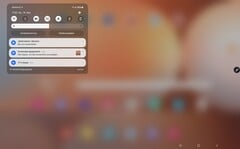

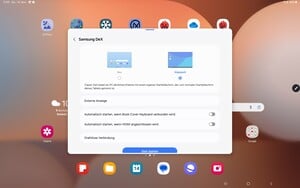















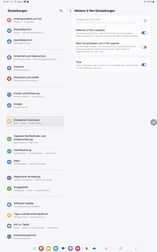



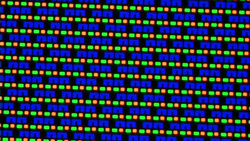






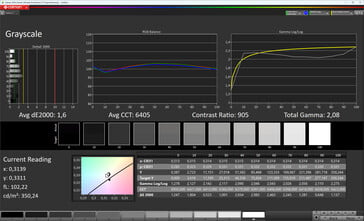



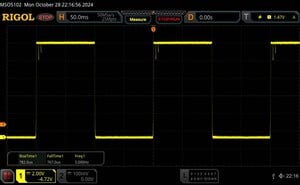








 Total Sustainability Score:
Total Sustainability Score: 








